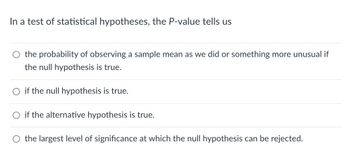
A First Course in Probability (10th Edition)
10th Edition
ISBN: 9780134753119
Author: Sheldon Ross
Publisher: PEARSON
expand_more
expand_more
format_list_bulleted
Question

Transcribed Image Text:In a test of statistical hypotheses, the P-value tells us
O the probability of observing a sample mean as we did or something more unusual if
the null hypothesis is true.
if the null hypothesis is true.
if the alternative hypothesis is true.
the largest level of significance at which the null hypothesis can be rejected.
Expert Solution
This question has been solved!
Explore an expertly crafted, step-by-step solution for a thorough understanding of key concepts.
Step by stepSolved in 3 steps

Knowledge Booster
Similar questions
- A public opinion poll surveyed a simple random sample of voters. Respondents were classified by gender (female or male) and by voting preference (Republican, Democrat, or Independent). The results are presented here: Republican 250 200 Female Male You want to determine if gender and voting preference are independent. Use a level of significance of a = 0.05. Are the requirements met for this hypothesis test? Explain. O Yes. A random sample was used, and all expected counts are greater than or equal to 5. O Yes. A random sample was used, and all observed counts are greater than or equal to 5. O No. A random sample was used, but at least one of the expected counts is less than 5. O No. A random sample was not used. Democrat 300 150 Independent 50 50arrow_forwardIf the decision in a hypothesis test said to reject Ho, then we can always make a conclusion that the sample data supports the claim. True Falsearrow_forwardtrue or false If the p-value is 0.13 and the level of significance , αα , is 0.05 in a hypothesis test for a mean, then we accept the null hypothesis.arrow_forward
- Is this what significance means? Statistical significance is very often mentioned in research reports. When asked what it means, a student replies that "results that are statistically significant tell us that they cannot easily be explained by chance variation alone if the hypothesis testing was true. Do you think this statement is essentially correct? Explain your answer.arrow_forwardTrue/False portion: 1) The sample mean x is a point estimate for the population mean u. 2) In tests of significance, it is possible to reject the null hypothesis and yet still have a significant result. 3) If one rejects the null hypothesis at the 5% level, then there is a 5% chance that you made the wrong decision.arrow_forwardWhat does the p-value represent in a test of hypothesis? The p-value represents the significance level of the hypothesis test. The p-value is the probability that the sample data occurred given that the null hypothesis is true. The p-value is the probability that the sample data occurred given that the alternative hypothesis is true. The p-value is the probability that the null hypothesis is true.arrow_forward
- Suppose you conduct 17 independent hypothesis tests each at the 8% significance level. Assume that every null hypothesis is true. The probability of making a type 1 error on a given test is 8%. What is the probability of making at least one error on 17 tests? Enter your answer as a probability, not a percent (so 0.456 rather than 45.6%). Round your answer to three decimal places.arrow_forwardWhich of the following is the name for the statistical hypothesis that describes no change, or nothing expected? Type I error Null hypothesis Type II error Alternative hypothesisarrow_forwardSuppose a hypothesis test was performed with a level of significance of 0.05. Then if the null hypothesis is actually true, then there is a 5% chance that the researcher will end up rejecting the null hypothesis in error. True Falsearrow_forward
- What does it mean when sample results are statistically significant?arrow_forward☐True ☐False As a general rule, as the sample size increases the probability of rejecting the null hypothesis decreases.arrow_forwardIf a significance test gives p-value 0.005... A.. the effect of interest is practically significant B...We do have good evidence against the null hypothesis C...we do not have good evidence against the null hypothesis D...the null hypothesis is very likely to be true E.. The margin of error is 0.005arrow_forward
arrow_back_ios
SEE MORE QUESTIONS
arrow_forward_ios
Recommended textbooks for you
 A First Course in Probability (10th Edition)ProbabilityISBN:9780134753119Author:Sheldon RossPublisher:PEARSON
A First Course in Probability (10th Edition)ProbabilityISBN:9780134753119Author:Sheldon RossPublisher:PEARSON

A First Course in Probability (10th Edition)
Probability
ISBN:9780134753119
Author:Sheldon Ross
Publisher:PEARSON
